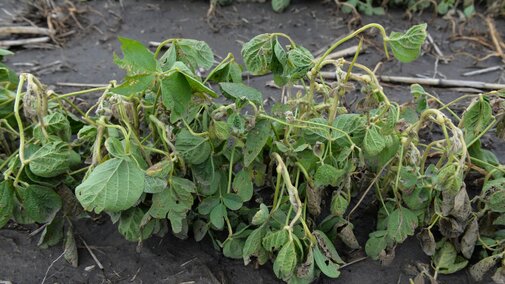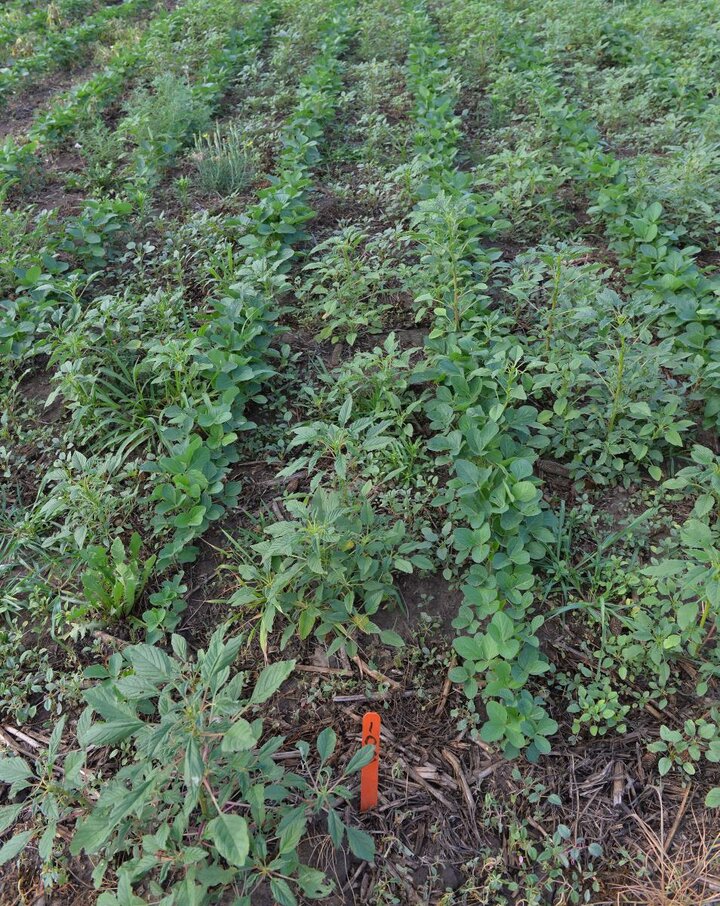
Soybean is the second most important crop in Nebraska, which is grown on 4.8 to 6 million acres annually and contributes about 7% to 10% of total soybean produced in the United States. For example, soybean was planted on 5.7 million acres in 2018 in Nebraska with the production of a record high 333 million bushels with an average of 59.0 bushels per acre (USDA, 2019). In 2019, however, soybean planting was 4.9 million acres due to early season flood and continuous rain (USDA-NASS 2020).
To achieve optimum yield, soybean production requires more careful field management — particularly for weed control — compared with other agronomic crops grown in eastern Nebraska such as corn, sorghum and wheat.
Objectives:
A number of herbicide-resistant soybean traits are available commercially in the market, making it complicated for growers to understand which soybean trait is resistant to what herbicide(s). The objectives of this NebGuide are:
(1) To provide information on seven herbicide-resistant soybean traits available in the marketplace and discuss which herbicides they are and are not resistant to.
(2) To provide information on factors to consider when applying herbicides in multiple herbicide-resistant soybean.
Herbicide-Resistant Soybean
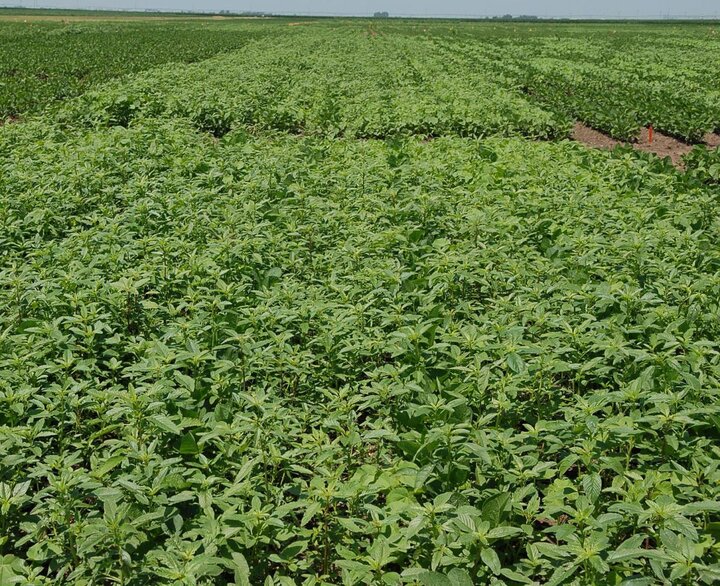
Glyphosate-resistant (Roundup Ready®) soybean came to the market in 1996 in the United States. Growers in Nebraska and other states rapidly adopted Roundup Ready® soybean because of flexibility in weed management using glyphosate, a broad-spectrum herbicide with post-emergence activity.
Majority of the respondents in a survey conducted in 2015 reported that glyphosate is the most commonly used post-emergence herbicide in glyphosate-resistant corn and soybean production fields in Nebraska (Sarangi and Jhala, 2018). Because of continuous and repeated use of glyphosate in glyphosate-resistant corn-soybean cropping systems, glyphosate-resistant weeds have evolved.
For example, six weeds have evolved resistant to glyphosate in Nebraska (Table 1). Management of glyphosate-resistant weeds is a challenge for soybean growers not only in Nebraska but also in several states in the Midwest (Figures 1–2). Several recommendations have been provided for management of glyphosate-resistant weeds including use of multiple herbicide-resistant crops. For instance, several traits of multiple herbicide-resistant soybean have been developed by industry primarily for management of glyphosate-resistant weeds (Table 2).
Roundup Ready 2 Xtend® Soybean: Roundup Ready 2 Xtend® soybean is resistant to glyphosate and dicamba. It came to the market in 2017. That year, 0.5 million acres were planted with Roundup Ready 2 Xtend® soybean in Nebraska and adoption of this trait increased rapidly. It is expected that about 60% of soybean in Nebraska would be Roundup Ready 2 Xtend® in 2020 (personal communication with Bayer Crop Science). The reason for rapid adoption of Roundup Ready 2 Xtend® soybean is primarily for control of glyphosate-resistant broadleaf weeds such as waterhemp, marestail (aka horseweed), and Palmer amaranth (aka carelessweed) (Figure 3) and to protect their soybean from dicamba off-target injury (Klein et al. 2018; Werle et al. 2018) (Figure 4).
LibertyLink® GT27™ Soybean: This soybean trait is resistant to isoxaflutole, glyphosate and glufosinate. Isoxaflutole is an HPPD (4-hydroxyphenylpyruvate dioxygenase)-inhibiting, Group 27 herbicide based on site of action. As of 2020, LibertyLink® GT27™ trait has been approved and seeds are available; however, isoxaflutole (Alite™ 27) is pending registration by the U.S. Environmental Protection Agency. Isoxaflutole (Balance® Flexx) is a residual herbicide that has been applied for weed control in corn since 1991, while Alite™ 27 is an isoxaflutole formulation to be used in LibertyLink® GT27™ soybean.
| # | Weed | Scientific Name | Family | Occurrence in Nebraska |
|---|---|---|---|---|
| 1 | Marestail (aka horseweed) | Erigeron canadensis L. | Asteraceae | Eastern |
| 2 | Kochia (aka burning bush) | Bassia scoparia L. | Amaranthaceae | West |
| 3 | Waterhemp | Amaranthus tuberculatus (Moq.) Sauer | Amaranthaceae | Eastern and west central |
| 4 | Giant ragweed (aka great ragweed) | Ambrosia trifida L. | Asteraceae | Isolated fields in east |
| 5 | Common ragweed (aka annual ragweed) | Ambrosia artemisiifolia L. | Asteraceae | Isolated fields in east |
| 6 | Palmer amaranth (aka carelessweed) | Amaranthus palmeri S. Watson | Amaranthaceae | Eastern and west central, Panhandle |
| # | Soybean Trait | Resistant to herbicide(s) | Manufacturer |
|---|---|---|---|
| 1 | Roundup Ready® | Glyphosate | Bayer Crop Science |
| 2 | Roundup Ready 2 Xtend® | Glyphosate/dicamba | Bayer Crop Science |
| 3 | LibertyLink® | Glufosinate | BASF |
| 4 | LibertyLink® GT27™ | Glyphosate/glufosinate/isoxaflutole | BASF |
| 5 | Enlist E3™ | Glyphosate/glufosinate/2,4-D choline | Corteva Agriscience |
| 6 | BOLT® | Glyphosate/thifensulfuron/rimsulfuron | Corteva Agriscience |
| 7 | *XtendFlex® | Glyphosate/glufosinate/dicamba | Bayer Crop Science |
*XtendFlex soybean is not available commercially in 2020, but it is anticipated that it will be available in the near future.
Enlist E3™ Soybean: Enlist E3™ soybean is resistant to 2,4-D choline, glyphosate and glufosinate. This trait became available to farmers in 2019. A new formulation, 2,4-D choline (Enlist One®), is less volatile than 2,4-D amine and 2,4-D ester. Enlist Duo® is a premix of 2,4-D choline and glyphosate. The Enlist soybean trait is NOT resistant to dicamba, so dicamba-based herbicides must NOT be applied. Additionally, DO NOT apply 2,4-D ester or 2,4-D amine to fields planted in Enlist E3™ soybean.
BOLT® Soybean: BOLT® soybean trait has been developed through traditional breeding approaches to provide enhanced resistance to sulfonylurea herbicides. This trait is the synergistic combination of two sulfonylurea tolerant soybean (STS®) genes — acetolactate synthase (ALS) 1 and ALS 2 — which provide improved tolerance to sulfonylurea herbicides compared to previously available sulfonylurea-tolerant soybean. Sulfonylurea-resistant soybean is also resistant to glyphosate. This trait allows the safe use and reduces the risk of soybean injury due to physical drift and carryover of sulfonylurea herbicides such as thifensulfuron and chlorimuron applied in crops such as wheat or rice.
XtendFlex®Soybean: XtendFlex® soybean is a triple-stacked soybean resistant to dicamba, glyphosate and glufosinate. Built on Roundup Ready 2 Xtend technology, farmers will get additional resistance to glufosinate (Cheetah®, Interline™, Liberty®, Total®, etc.) for more flexibility and herbicide choice to manage glyphosate-resistant weeds. This soybean trait is not available commercially as of 2020 and will be available in the near future.
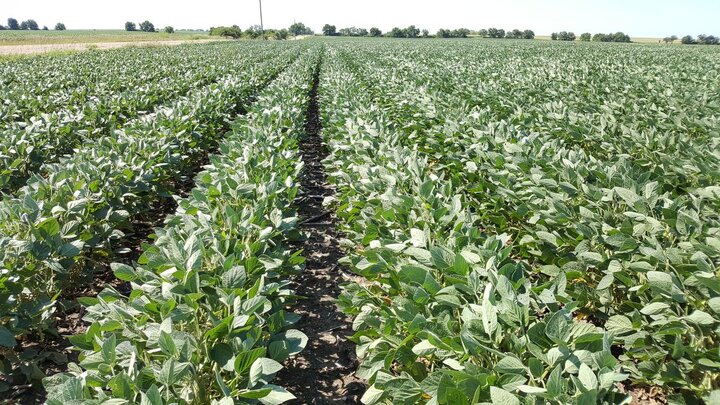

Factors to Consider:
Because of coexistence of multiple herbicide-resistant soybean with conventional soybean, there are a number of factors to consider.
- Pre-emergence herbicides are a foundation for early season weed control in soybean. All labeled pre-emergence herbicide(s) in soybean can be applied in all type of multiple herbicide-resistant soybean traits, except isoxaflutole (Alite™ 27) ─ can only be applied in LibertyLink®GT27™ soybean.
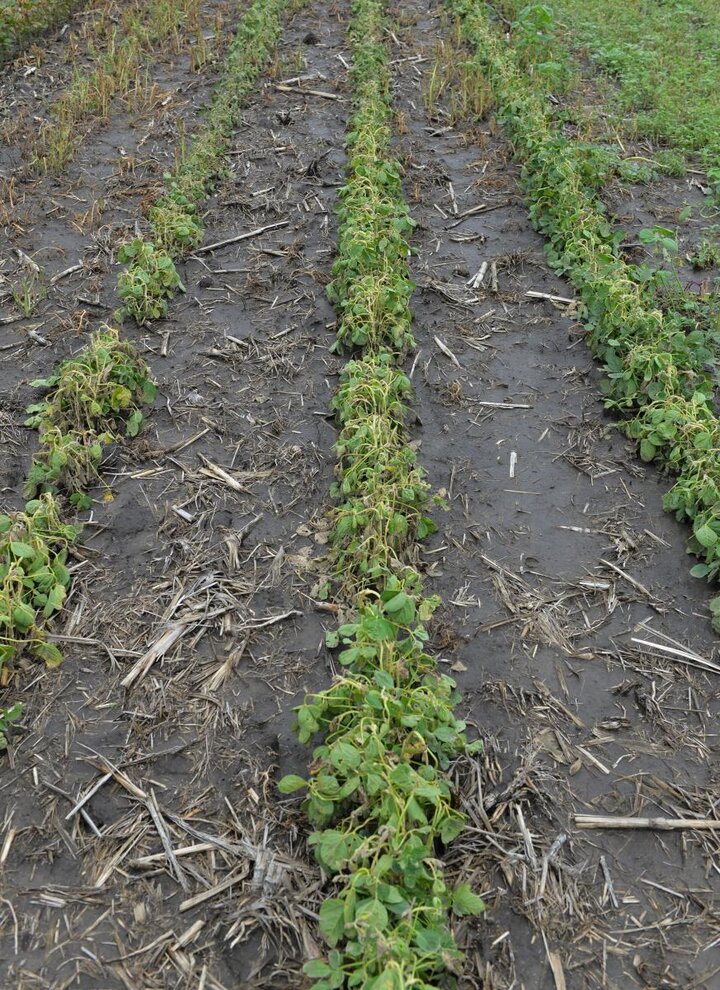
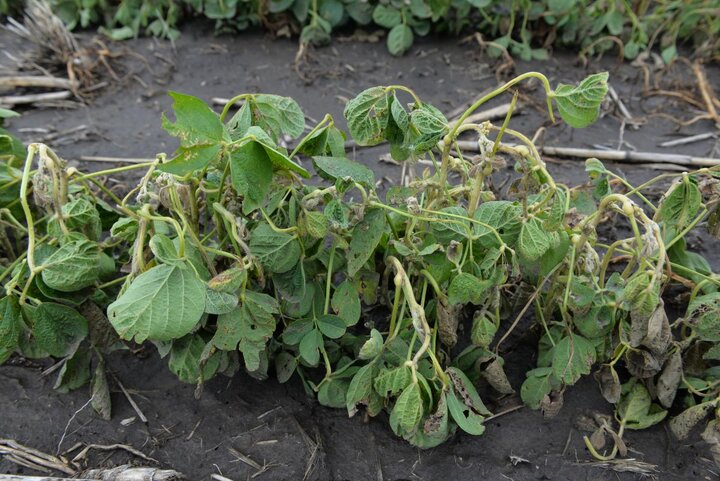
Figures 5A–5B. What NOT to Do: Apply dicamba (XtendiMax®) on LibertyLink® soybean. Both photos were taken on June 25, 2018, in a project conducted at South Central Agriculture Lab near Clay Center, Nebraska.
- Growers and certified pesticide applicators have to be careful when selecting and applying post-emergence herbicides in multiple herbicide-resistant soybeans. Post-emergence herbicides must be selected depending on which soybean trait you have planted. For example, when Roundup Ready 2 Xtend® soybean is planted, dicamba-based herbicides such as XtendiMax®, Engenia®, FeXapan® or Tavium® can be applied.
- Several growers rely on certified pesticide applicators for their herbicide application. Therefore, good communication is needed between the owner or leaseholder of the field and the certified applicator to make sure the applicator knows which soybean trait is planted in which field and what herbicide(s) to spray.
- There are some conventional/organic soybean growers in Nebraska. Care must be taken when conventional and organic soybean fields are in proximity to avoid off-target injury from post-emergence herbicides applied in multiple herbicide-resistant soybean. Organic and specialty crop growers should register on Drift Watch. This site is a voluntary communication tool that enables organic and specialty crop producers and pesticide applicators to work together to protect from off-target injury through use of mapping programs.
What NOT to Do When Multiple Herbicide-Resistant Soybean Coexist:
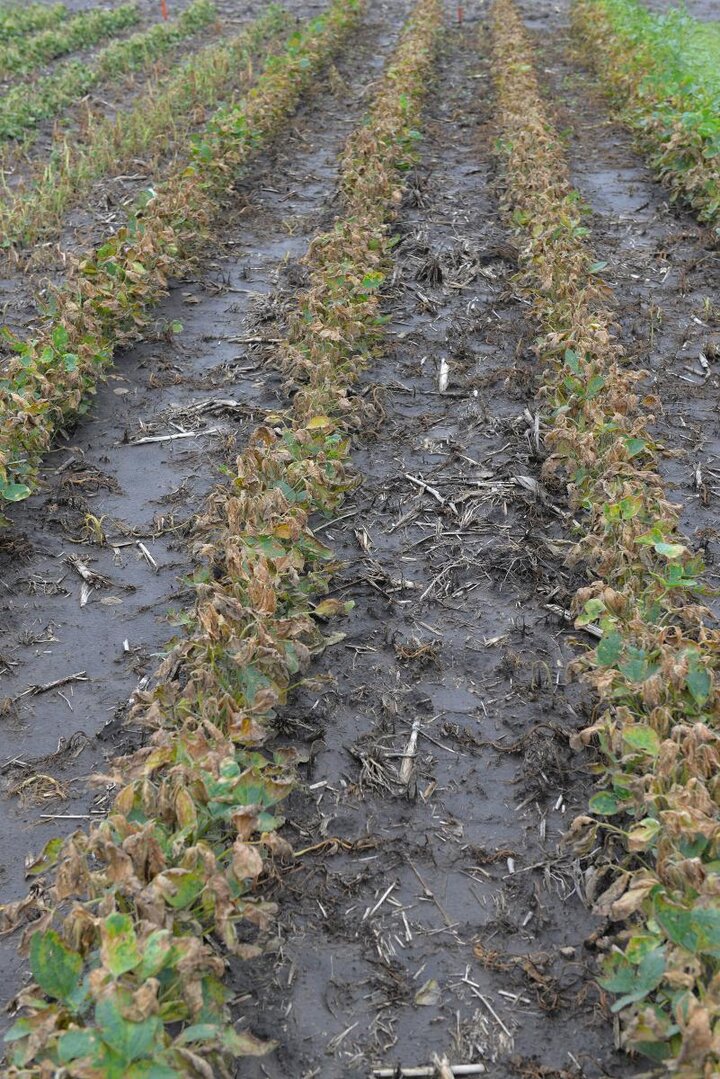

Figures 6A-6B. What NOT to Do: Apply glufosinate (Liberty®) on Roundup Ready 2 Xtend soybean. These photos were taken June 25, 2018, in a project conducted at South Central Agriculture Lab near Clay Center, Nebraska.
- While it is good to have the opportunity of planting different multiple herbicide-resistant soybean traits for management of glyphosate-resistant weeds, it is critically important NOT to spray the wrong herbicide on your crops. Additionally, it is vitally important to pay attention to soybean trait planted and select post-emergence herbicides accordingly.
Case Study #1
- If LibertyLink soybean is planted, do NOT spray dicamba-based herbicides because LibertyLink soybean is NOT resistant to dicamba. A significant damage could occur with this type of mistake (Figures 5A-5B). Additionally, do NOT apply Liberty herbicide on Roundup Ready 2 Xtend® soybean (Figures 6A-6B).
Case Study #2
- Do NOT apply 2,4-D choline in Roundup Ready 2 Xtend® soybean because Roundup Ready 2 Xtend® soybean is NOT resistant to 2,4-D (Figures 7A–7B).
Herbicide-Resistant Weed Management in Multiple Herbicide-Resistant Soybean:
- While multiple herbicide-resistant soybean traits are providing opportunities to use additional herbicide(s) for management of glyphosate-resistant weeds, their use should be carefully managed to avoid the same herbicide in corn-soybean cropping systems. For example, with the availability of Roundup Ready 2 Xtend® soybean, growers can use dicamba-based herbicides; however, dicamba is also a labeled herbicide in corn. Therefore, when dicamba is applied in Roundup Ready 2 Xtend® soybean, another herbicide should be selected the following year for corn to avoid selection pressure of dicamba.
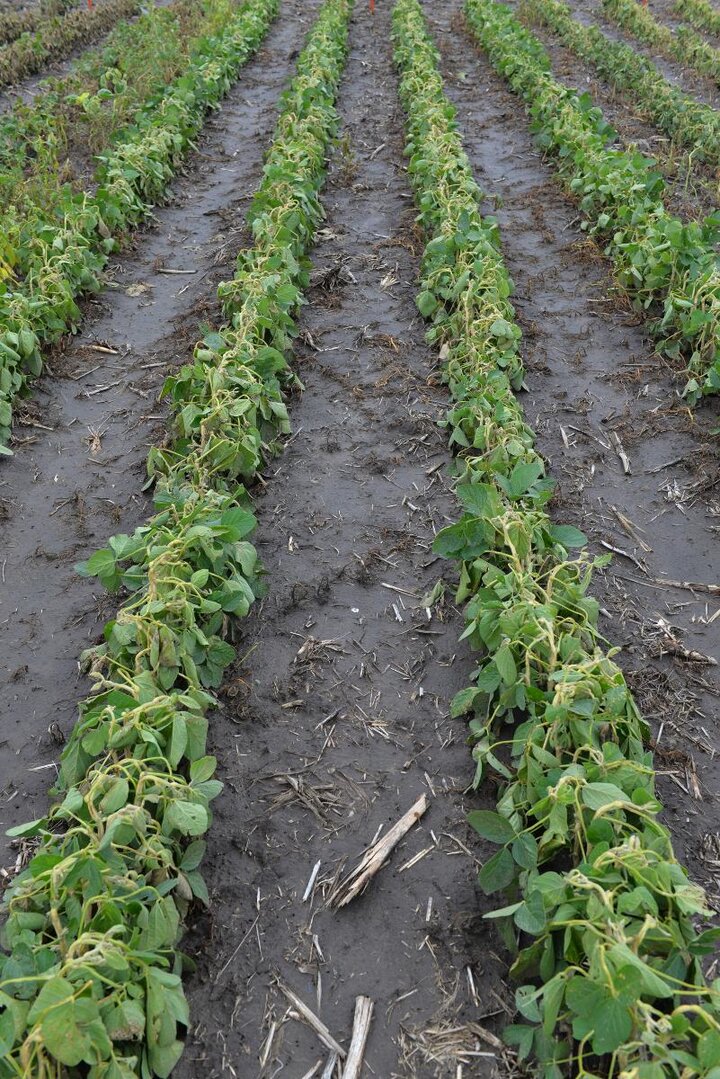
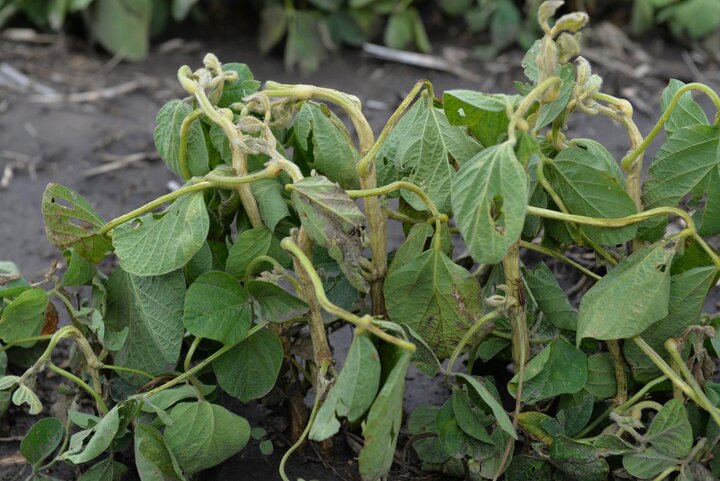
Figures 7A-7B. What NOT to Do: Apply 2,4-D choline (Enlist One®) on Roundup Ready 2 Xtend® soybean. These photos were taken June 25, 2018, in a project conducted at South Central Agriculture Lab near Clay Center, Nebraska.
- Residual premix herbicide with multiple effective sites of action should be used in corn and soybean for effective control of weeds. This will reduce reliance on a single or sequential post-emergence herbicide application and the number of weeds exposed to post-emergence herbicides.
- Do NOT apply a reduced rate or more than the labeled rate of any herbicide in a single application or in multiple applications. Carefully read and follow herbicide labels. Concerning herbicide options, refer to the University of Nebraska-Lincoln Extension’s Guide for Weed, Disease, and Insect Management in Nebraska, which is updated annually.
References
Klein R, Jhala AJ, Pryor R, Knezevic SZ, Rees J, Whitney T (2018) Can we manage dicamba applications in 2018? CropWatch. Feb 15, 2018. https://cropwatch.unl.edu/2018/can-we-manage-dicamba-applications-2018.
Sarangi D, Jhala AJ (2018) A statewide survey of stakeholders to access the problem weeds and weed management practices in Nebraska. Weed Technology 32:642–655.
USDA (2019) U.S. Department of Agriculture reports Nebraska corn and soybean production hit record highs https://cropwatch.unl.edu/2019/usda-2018-annual-crop-report-nebraska.
USDA-NASS (2020). Crop Production Annual Summary. U.S. Department of Agriculture ─ National Agricultural Statistics Service. Jan 10, 2020. Available at https://usda.library.cornell.edu/concern/publications/k3569432s.
Werle R, Oliveira MC, Jhala AJ, Proctor C, Rees J, Klein R (2018) Survey of Nebraska farmers’ adoption of dicamba-resistant soybean technology and dicamba off-target movement. Weed Technology 32:554-561.
